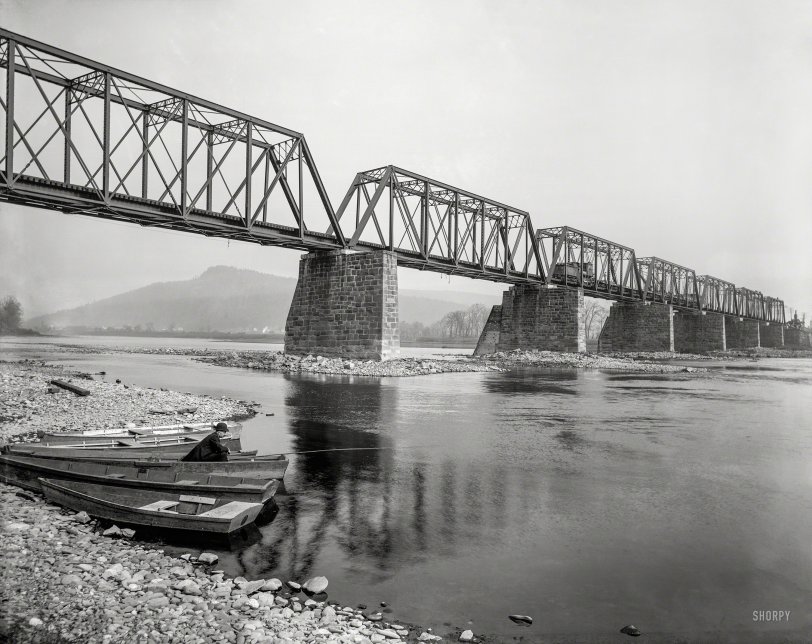


Framed or unframed, desk size to sofa size, printed by us in Arizona and Alabama since 2007. Explore now.
Shorpy is funded by you. Patreon contributors get an ad-free experience.
Learn more.

- Details, Details
- What's that building to the left of the tower?
- Coal Barges
- Bromo-Seltzer
- Inner harbor
- The Basin
- What a headache!
- Giant stepladder?
- Baldwin 62303
- Baldwin VO-1000
- Cold
- No expense spared
- Tough Guys
- Lost in Toyland
- And without gloves
- If I were a blindfolded time traveler
- Smoke Consumer Also Cooks
- Oh that stove!
- Possibly still there?
- What?!?
- $100 Reward
- Freeze Frame
- Texas Flyer wanted
- Just a Year Too Soon
- WWII -- Replacing men with women at the railroad crossing.
- Yes, Icing
- You kids drive me nuts!
- NOT An Easy Job
- I wonder
- Just add window boxes
Print Emporium
Compleat Angler: 1901

Circa 1901. "Bridge over the Susquehanna at Pittston, Pennsylvania." 8x10 inch dry plate glass negative, Detroit Publishing Company. View full size.
Bridge Supports
The Pennsylvania Railroad and her subsidiaries would typically build bridges in this manner, with a piling wide enough to accommodate two tracks; but only place one track over the bridge. The reasoning, at least for the railroad, was that if traffic or demand ever became such that a second track needed added; it was simply easier to plunk a new bridge down on the extra width. This also meant that the existing line would not need to be closed during the construction.
The locomotive in question looks to be one of the PRR's 4-4-0 camelback types, though it's possibly a 4-6-0. (Can not tell from the angle.) Here is an image of the possible locomotive type.
I've fished exactly where he is, probably 80 years later.
Technically this fellow is sitting in West Pittston, not Pittston itself, which is what you're looking at across the river. West Pittston and Pittston are two separate towns, with different school districts. So we Wyoming Area Warriors considered the Pittston Patriots our sworn enemies. Of course back then, the worst you did to your enemy was maybe TP the trees in their front yard. That always showed 'em!
Regarding the fishing, he's probably fishing for his dinner. Many years later, we caught a lot, but never ate them, since the river these days is pretty, but not necessarily something you want to eat out of.
And one final thing for jaylgordon-the bridge abutments are slanted like that on the upriver side, to allow debris flowing downstream to more easily roll off and not get stuck on them.
Camelback
The locomotive on the bridge is a type called a Camelback. The engineer and brakeman sat in a cab that straddled the boiler in the middle of the locomotive. The fireman had his own shelter at the rear to transfer coal from the tender to the boiler firebox.
The reason for this design was that they burned local Anthracite coal which is very high in fixed carbon. It burns hot but slowly, like charcoal. To get enough heat to power the locomotive the firebox had to be almost as wide as the locomotive, making it impossible for the engineer to see ahead from a rear mounted cab. The solution was to put the cab ahead of the firebox.
Fishing For?
Bullhead catfish or sunfish I'm guessing, since he's still-fishing. Bullheads on bottom, sunnies if he's using a float. The smallmouth bass so sought after on the Susquehanna these days had probably not been imported yet--they're not native. Carp were only beginning to become unwanted guests in America's rivers.
Why is the bridge on one side of the supports?
I am wondering why the bridge is on only one side of the supports. Would another track have been put beside it eventually? Or was this how they were constructed-- I notice that the side holding up the track seem reinforced with stone coming down at an angle.
























On Shorpy:
Today’s Top 5